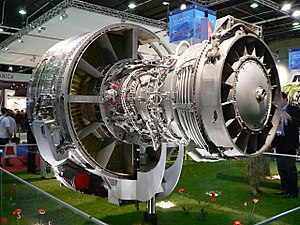CFM56
| CFM56 | |
|---|---|
 |
|
| Rear view of a CFM56-5 | |
| Type | Turbofan |
| National origin | France and United States |
| Manufacturer | CFM International |
| First run | June 1974 |
| Major applications |
Airbus A320 family Airbus A340 Boeing 737 Classic / Next Gen. McDonnell Douglas DC-8-70 series KC-135R Stratotanker |
| Number built | 30,000 (as of July 2016) |
| Unit cost | US$10 million (list price) |
| Developed from | General Electric F101 |
| Developed into | CFM International LEAP |
The CFM International CFM56 (U.S. military designation F108) series is a family of high-bypass turbofan aircraft engines made by CFM International (CFMI), with a thrust range of 18,500 to 34,000 pounds-force (82 to 150 kilonewtons). CFMI is a 50–50 joint-owned company of Safran Aircraft Engines (formerly known as SNECMA), France, and GE Aviation (GE), United States. Both companies are responsible for producing components and each has its own final assembly line. GE produces the high-pressure compressor, combustor, and high-pressure turbine, SNECMA manufactures the fan, gearbox, exhaust and the low-pressure turbine, and some components are made by Avio of Italy. The engines are assembled by GE in Evendale, Ohio, and by SNECMA in Villaroche, France. The completed engines are marketed by CFMI. Despite initial export restrictions, it is one of the most common turbofan aircraft engines in the world, in four major variants.
The CFM56 first ran in 1974. In April 1979, the joint venture had not received a single order in five years and was two weeks away from being dissolved. The program was saved when Delta Airlines, United Airlines, and Flying Tigers chose the CFM56 to re-engine their DC-8s and shortly thereafter it was chosen to re-engine the KC-135 Stratotanker fleet of the U.S. Air Force – still its biggest customer. The first engines entered service in 1982. Several fan blade failure incidents were experienced during the CFM56's early service, including one failure that was a cause of the Kegworth air disaster, and some engine variants experienced problems caused by flight through rain and hail. Both these issues were resolved with engine modifications.
...
Wikipedia
